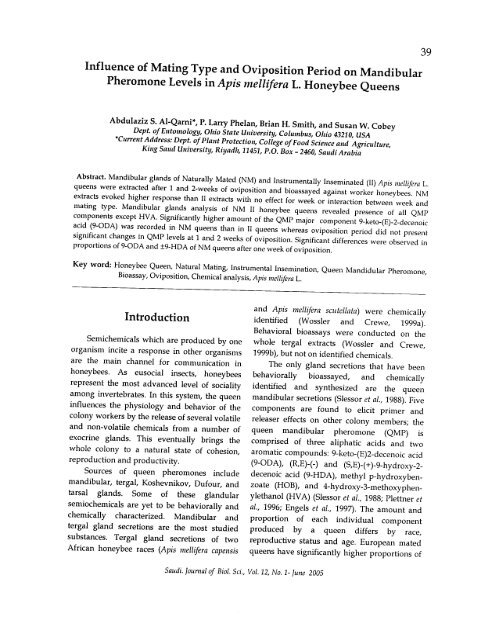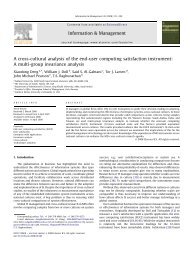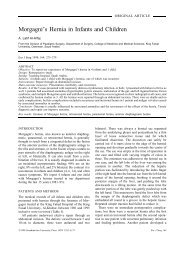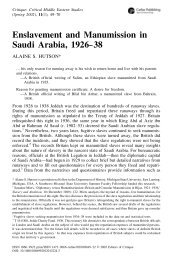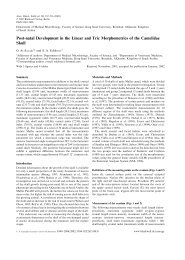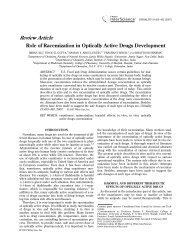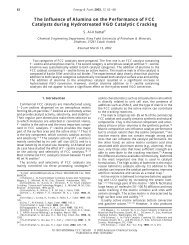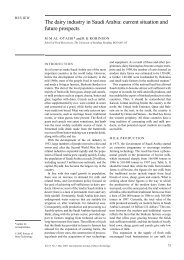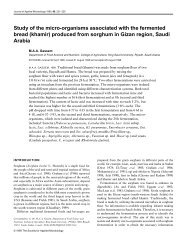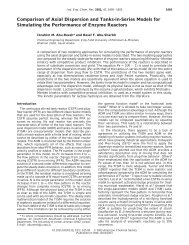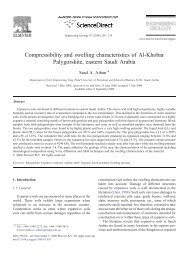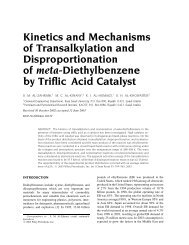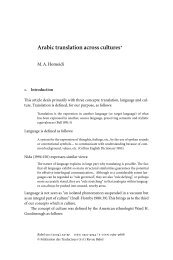Influence of Mating Type and Oviposition Period on Mandibular ...
Influence of Mating Type and Oviposition Period on Mandibular ...
Influence of Mating Type and Oviposition Period on Mandibular ...
Create successful ePaper yourself
Turn your PDF publications into a flip-book with our unique Google optimized e-Paper software.
<str<strong>on</strong>g>Influence</str<strong>on</strong>g> <str<strong>on</strong>g>of</str<strong>on</strong>g> <str<strong>on</strong>g>Mating</str<strong>on</strong>g> <str<strong>on</strong>g>Type</str<strong>on</strong>g> <str<strong>on</strong>g>and</str<strong>on</strong>g> <str<strong>on</strong>g>Ovipositi<strong>on</strong></str<strong>on</strong>g> <str<strong>on</strong>g>Period</str<strong>on</strong>g> <strong>on</strong> M<str<strong>on</strong>g>and</str<strong>on</strong>g>ibular<br />
Pherom<strong>on</strong>e Levels in Apis melli/era L. H<strong>on</strong>eybee Queens<br />
Abdulaziz S. AI-Qarni"", P. Larry Phelan, Brian H. Smith, <str<strong>on</strong>g>and</str<strong>on</strong>g> Susan W. Cobey<br />
Dept. <str<strong>on</strong>g>of</str<strong>on</strong>g> Entomology, Ohio State Ulliversity, Columbus, Ohio 43210, USA<br />
""CurrentAddress: Dept. <str<strong>on</strong>g>of</str<strong>on</strong>g> Plant Protectioll, College <str<strong>on</strong>g>of</str<strong>on</strong>g> Food Science <str<strong>on</strong>g>and</str<strong>on</strong>g> Agriculture,<br />
King Saud Universihj, Riyadh, 11451, P.O. Box - 2460, Saudi Arabia<br />
Abstract. M<str<strong>on</strong>g>and</str<strong>on</strong>g>ibular gl<str<strong>on</strong>g>and</str<strong>on</strong>g>s <str<strong>on</strong>g>of</str<strong>on</strong>g> Naturally Mated (NM)<str<strong>on</strong>g>and</str<strong>on</strong>g> Instrumentally Inseminated (II)Apis mellifera L.<br />
queens were extracted after 1 <str<strong>on</strong>g>and</str<strong>on</strong>g> 2-weeks <str<strong>on</strong>g>of</str<strong>on</strong>g> ovipositi<strong>on</strong> <str<strong>on</strong>g>and</str<strong>on</strong>g> bioassayed against worker h<strong>on</strong>eybees. NM<br />
extracts evoked higher resp<strong>on</strong>se than II extracts with no effect for week or interacti<strong>on</strong> between week <str<strong>on</strong>g>and</str<strong>on</strong>g><br />
mating type. M<str<strong>on</strong>g>and</str<strong>on</strong>g>ibular gl<str<strong>on</strong>g>and</str<strong>on</strong>g>s analysis <str<strong>on</strong>g>of</str<strong>on</strong>g> NM II h<strong>on</strong>eybee queens revealed presence <str<strong>on</strong>g>of</str<strong>on</strong>g> all QMP<br />
comp<strong>on</strong>ents except HVA. Significantlyhigher amount <str<strong>on</strong>g>of</str<strong>on</strong>g> the QMP major comp<strong>on</strong>ent 9-keto-(E)-2-decenoic<br />
acid (9-0DA) was recorded in NM queens than in II queens whereas ovipositi<strong>on</strong> period did not present<br />
significant changes in QMP levels at 1 <str<strong>on</strong>g>and</str<strong>on</strong>g> 2 weeks <str<strong>on</strong>g>of</str<strong>on</strong>g> ovipositi<strong>on</strong>. Significant differences were observed in<br />
proporti<strong>on</strong>s <str<strong>on</strong>g>of</str<strong>on</strong>g> 9-0DA <str<strong>on</strong>g>and</str<strong>on</strong>g> ±9-HDA<str<strong>on</strong>g>of</str<strong>on</strong>g> NM queens after <strong>on</strong>e week <str<strong>on</strong>g>of</str<strong>on</strong>g> ovipositi<strong>on</strong>.<br />
Key word: H<strong>on</strong>eybee Queen, Natural <str<strong>on</strong>g>Mating</str<strong>on</strong>g>, Instrumental Inseminati<strong>on</strong>, Queen M<str<strong>on</strong>g>and</str<strong>on</strong>g>idular Pherom<strong>on</strong>e,<br />
Bioassay,<str<strong>on</strong>g>Ovipositi<strong>on</strong></str<strong>on</strong>g>, Chemicalanalysis, Apis mellifera L.<br />
Semichemicals which are produced by <strong>on</strong>e<br />
organism incite a resp<strong>on</strong>se in other organisms<br />
are the main channel for communicati<strong>on</strong> in<br />
h<strong>on</strong>eybees. As eusocial insects, h<strong>on</strong>eybees<br />
represent the most advanced level <str<strong>on</strong>g>of</str<strong>on</strong>g> sociality<br />
am<strong>on</strong>g invertebrates. In this system, the queen<br />
influences the physiology <str<strong>on</strong>g>and</str<strong>on</strong>g> behavior <str<strong>on</strong>g>of</str<strong>on</strong>g> the<br />
col<strong>on</strong>y workers by the release <str<strong>on</strong>g>of</str<strong>on</strong>g> several volatile<br />
<str<strong>on</strong>g>and</str<strong>on</strong>g> n<strong>on</strong>-volatile chemicals from a number <str<strong>on</strong>g>of</str<strong>on</strong>g><br />
exocrine gl<str<strong>on</strong>g>and</str<strong>on</strong>g>s. This eventually brings the<br />
whole col<strong>on</strong>y to a natural state <str<strong>on</strong>g>of</str<strong>on</strong>g> cohesi<strong>on</strong>,<br />
reproducti<strong>on</strong> <str<strong>on</strong>g>and</str<strong>on</strong>g> productivity.<br />
Sources <str<strong>on</strong>g>of</str<strong>on</strong>g> queen pherom<strong>on</strong>es include<br />
m<str<strong>on</strong>g>and</str<strong>on</strong>g>ibular, tergal, Koshevnikov, Dufour, <str<strong>on</strong>g>and</str<strong>on</strong>g><br />
tarsal gl<str<strong>on</strong>g>and</str<strong>on</strong>g>s. Some <str<strong>on</strong>g>of</str<strong>on</strong>g> these gl<str<strong>on</strong>g>and</str<strong>on</strong>g>ular<br />
semiochemicals are yet to be behaviorally <str<strong>on</strong>g>and</str<strong>on</strong>g><br />
chemically characterized. M<str<strong>on</strong>g>and</str<strong>on</strong>g>ibular <str<strong>on</strong>g>and</str<strong>on</strong>g><br />
tergal gl<str<strong>on</strong>g>and</str<strong>on</strong>g> secreti<strong>on</strong>s are the most studied<br />
substances. Tergal gl<str<strong>on</strong>g>and</str<strong>on</strong>g> secreti<strong>on</strong>s <str<strong>on</strong>g>of</str<strong>on</strong>g> two<br />
African h<strong>on</strong>eybee races (Apis mellifera capensis<br />
<str<strong>on</strong>g>and</str<strong>on</strong>g> Apis mellifera scutellata) were chemically<br />
identified (Wossler <str<strong>on</strong>g>and</str<strong>on</strong>g> Crewe, 1999a).<br />
Behavioral bioassays were c<strong>on</strong>ducted <strong>on</strong> the<br />
whole tergal extracts (Wossler <str<strong>on</strong>g>and</str<strong>on</strong>g> Crewe,<br />
1999b), but not <strong>on</strong> identified chemicals.<br />
The <strong>on</strong>ly gl<str<strong>on</strong>g>and</str<strong>on</strong>g> secreti<strong>on</strong>s that have been<br />
behaviorally bioassayed, <str<strong>on</strong>g>and</str<strong>on</strong>g> chemically<br />
identified <str<strong>on</strong>g>and</str<strong>on</strong>g> synthesized are the queen<br />
m<str<strong>on</strong>g>and</str<strong>on</strong>g>ibular secreti<strong>on</strong>s (Siessor et al., 1988). Five<br />
comp<strong>on</strong>ents are found to elicit primer <str<strong>on</strong>g>and</str<strong>on</strong>g><br />
releaser effects <strong>on</strong> other col<strong>on</strong>y members; the<br />
queen m<str<strong>on</strong>g>and</str<strong>on</strong>g>ibular pherom<strong>on</strong>e (QMP) is<br />
comprised <str<strong>on</strong>g>of</str<strong>on</strong>g> three aliphatic acids <str<strong>on</strong>g>and</str<strong>on</strong>g> two<br />
aromatic compounds: 9-keto-(E)2-decenoic acid<br />
(9-0DA), (R,E)-(-) <str<strong>on</strong>g>and</str<strong>on</strong>g> (S,E)-(+)-9-hydroxy-2-<br />
decenoic acid (9-HDA), methyl p-hydroxybenzoate<br />
(HOB), <str<strong>on</strong>g>and</str<strong>on</strong>g> 4-hydroxy-3-methoxyphenylethanol<br />
(HVA) (Siessor et ai., 1988; Plettner et<br />
al., 1996; Engels et ai., 1997). The amount <str<strong>on</strong>g>and</str<strong>on</strong>g><br />
proporti<strong>on</strong> <str<strong>on</strong>g>of</str<strong>on</strong>g> each individual comp<strong>on</strong>ent<br />
produced by a queen differs by race,<br />
reproductive status <str<strong>on</strong>g>and</str<strong>on</strong>g> age. European mated<br />
queens have significantly higher proporti<strong>on</strong>s <str<strong>on</strong>g>of</str<strong>on</strong>g>
9-0DA, HOB, <str<strong>on</strong>g>and</str<strong>on</strong>g> HVA in the QMS bouquet,<br />
while Africanized mated queens have<br />
significantly higher proporti<strong>on</strong>s <str<strong>on</strong>g>of</str<strong>on</strong>g> (+) <str<strong>on</strong>g>and</str<strong>on</strong>g> (-) 9-<br />
HDA. Virgin European queens have a higher<br />
proporti<strong>on</strong>s <str<strong>on</strong>g>of</str<strong>on</strong>g> 9-0DA, while mated European<br />
queens have roughly equal proporti<strong>on</strong>s <str<strong>on</strong>g>of</str<strong>on</strong>g> 9-<br />
ODA <str<strong>on</strong>g>and</str<strong>on</strong>g> 9-HDA. The average amount <str<strong>on</strong>g>of</str<strong>on</strong>g> the<br />
QMP found in a pair <str<strong>on</strong>g>of</str<strong>on</strong>g> m<str<strong>on</strong>g>and</str<strong>on</strong>g>ibular gl<str<strong>on</strong>g>and</str<strong>on</strong>g>s <str<strong>on</strong>g>of</str<strong>on</strong>g> a<br />
European mated queen was found to be: 200 I.l<br />
9-0DA, 80 I.lg9-HAD, 20 I.lgHOB, <str<strong>on</strong>g>and</str<strong>on</strong>g> 2 I.lg<br />
HVA (Pankiw et al., 1996).<br />
Functi<strong>on</strong>s <str<strong>on</strong>g>of</str<strong>on</strong>g> queen m<str<strong>on</strong>g>and</str<strong>on</strong>g>ibular pherom<strong>on</strong>es<br />
include both primer <str<strong>on</strong>g>and</str<strong>on</strong>g> releaser effects<br />
<strong>on</strong> worker bees. As a primer pherom<strong>on</strong>e, it was<br />
found to inhibit queen rearing by workers<br />
(Butler, 1954, 1960; Butler <str<strong>on</strong>g>and</str<strong>on</strong>g> Simps<strong>on</strong>, 1958;<br />
Winst<strong>on</strong> et al., 1989, 1990; Pettis et al., 1995),<br />
stimulate pollen foraging <str<strong>on</strong>g>and</str<strong>on</strong>g> brood rearing in<br />
small, newly founded col<strong>on</strong>ies (Higo et al.,<br />
1992), inhibit worker juvenile horm<strong>on</strong>e OH)<br />
biosynthesis in laboratory experiments (Kaatz<br />
et al., 1992), <str<strong>on</strong>g>and</str<strong>on</strong>g> regulate the transiti<strong>on</strong> <str<strong>on</strong>g>of</str<strong>on</strong>g><br />
worker activity from within-hive to foraging<br />
duties by lowering their juvenile horm<strong>on</strong>e titers<br />
in col<strong>on</strong>ies (Pankiwe et al., 1998). C<strong>on</strong>trary to<br />
earlier findings, Willis et al., (1990) reported<br />
that QMP does not affect ovarian development<br />
in worker bees. The releaser effects <str<strong>on</strong>g>of</str<strong>on</strong>g> QMP<br />
include attracti<strong>on</strong> <str<strong>on</strong>g>of</str<strong>on</strong>g> workers to form retinue<br />
around the queen inside the col<strong>on</strong>y (Velthuis,<br />
1967; Winst<strong>on</strong> et al., 1982, 1989; Slessor et al.,<br />
1988; Kaminski et al., 1990), attracti<strong>on</strong> <str<strong>on</strong>g>of</str<strong>on</strong>g><br />
workers during swarming outside the col<strong>on</strong>y<br />
(Velthuis <str<strong>on</strong>g>and</str<strong>on</strong>g> Van Es, 1964; Butler <str<strong>on</strong>g>and</str<strong>on</strong>g><br />
Simps<strong>on</strong>, 1967; Winst<strong>on</strong> et al., 1989), <str<strong>on</strong>g>and</str<strong>on</strong>g><br />
attracti<strong>on</strong> <str<strong>on</strong>g>of</str<strong>on</strong>g> dr<strong>on</strong>es to the queen during mating<br />
flights (Butler <str<strong>on</strong>g>and</str<strong>on</strong>g> Fairey, 1964; Loper et al.,<br />
1996).<br />
As the main channel <str<strong>on</strong>g>of</str<strong>on</strong>g> communicati<strong>on</strong>,<br />
queen pherom<strong>on</strong>es have critical importance<br />
during introducti<strong>on</strong> <str<strong>on</strong>g>of</str<strong>on</strong>g> a new mated queen to a<br />
queenless col<strong>on</strong>y. Beekeepers are advised to<br />
replace their queens annually to maintain goodquality<br />
performance for their queens <str<strong>on</strong>g>and</str<strong>on</strong>g><br />
col<strong>on</strong>ies <str<strong>on</strong>g>and</str<strong>on</strong>g> to maintain low levels <str<strong>on</strong>g>of</str<strong>on</strong>g><br />
Africanizati<strong>on</strong> in commercial col<strong>on</strong>ies.<br />
Superseded queens that have mated with<br />
Africanized dr<strong>on</strong>es can result in col<strong>on</strong>ies with<br />
n<strong>on</strong>-commercial properties (Guzman-Nova et<br />
al., 1998) such as high defensive proclivity, high<br />
rate <str<strong>on</strong>g>of</str<strong>on</strong>g> swarming <str<strong>on</strong>g>and</str<strong>on</strong>g> probability to absc<strong>on</strong>d<br />
(Collins et al., 1982; Otis, 1982; Winst<strong>on</strong> et al.,<br />
1979).<br />
Col<strong>on</strong>ies that are led by young queens « 1<br />
yr. old) produce more h<strong>on</strong>ey than col<strong>on</strong>ies led<br />
by old queens (Kostarelou-Demianidou et al.,<br />
1995). Old queens' progenies could also have<br />
undesirable characteristics (e.g. high succeptibility<br />
to diseases <str<strong>on</strong>g>and</str<strong>on</strong>g> str<strong>on</strong>g defensive<br />
behavior), which prompts beekeerpers to<br />
replace them with younger <strong>on</strong>es (Free, 1987).<br />
This regularly performed procedure requires a<br />
period <str<strong>on</strong>g>of</str<strong>on</strong>g> queenlessness <strong>on</strong> workers bees prior<br />
to introducing a new queen to the col<strong>on</strong>y.<br />
However, worker bees in a queenless col<strong>on</strong>y<br />
become more excited <str<strong>on</strong>g>and</str<strong>on</strong>g> sensitive to<br />
examinati<strong>on</strong>s as the queenlessness period<br />
c<strong>on</strong>tinues. They aggressively attack a foreign<br />
introduced queen by the act <str<strong>on</strong>g>of</str<strong>on</strong>g> mounting,<br />
biting, pulling, <str<strong>on</strong>g>and</str<strong>on</strong>g> stinging. Eventually, this<br />
initiates the balling behavior when workers<br />
start to form a cluster <str<strong>on</strong>g>of</str<strong>on</strong>g> bees around the queen,<br />
usually resulting in queen eliminati<strong>on</strong> (Yavada,<br />
1970;Boch <str<strong>on</strong>g>and</str<strong>on</strong>g> Morse, 1974;Pettis et al., 1998).<br />
In spite <str<strong>on</strong>g>of</str<strong>on</strong>g> reducing workers' rejecti<strong>on</strong> by<br />
caging foreign queens during introducti<strong>on</strong> for<br />
24 hr, this natural behavior <str<strong>on</strong>g>of</str<strong>on</strong>g> workers was<br />
found to be more frequent towards<br />
instrumentally inseminated queens (II) than<br />
naturally mated queens (NM). II queens have<br />
been reported to have problems with initial<br />
introducti<strong>on</strong> <str<strong>on</strong>g>and</str<strong>on</strong>g> acceptance, <str<strong>on</strong>g>and</str<strong>on</strong>g> with early<br />
supersedure (Smith et al., 1993; Harbo <str<strong>on</strong>g>and</str<strong>on</strong>g><br />
Szabo, 1984). II queens were also found to have<br />
lower ovipositi<strong>on</strong> rates than NM queens<br />
(Harbo, 1986a). Nevertheless, the use <str<strong>on</strong>g>of</str<strong>on</strong>g><br />
instrumental inseminati<strong>on</strong> for h<strong>on</strong>eybee queens<br />
is <str<strong>on</strong>g>of</str<strong>on</strong>g> great value to the beekeeping industry as a<br />
tool for bee breeders <str<strong>on</strong>g>and</str<strong>on</strong>g> queen producers to<br />
increase the quality <str<strong>on</strong>g>of</str<strong>on</strong>g> h<strong>on</strong>eybee races. Natural
mating can result in bees with undesirable<br />
characters that might come from dr<strong>on</strong>es <str<strong>on</strong>g>of</str<strong>on</strong>g><br />
unknown origin.<br />
The study was carried during Spring, 2000<br />
to ascertain the effect <str<strong>on</strong>g>of</str<strong>on</strong>g> mating type <str<strong>on</strong>g>and</str<strong>on</strong>g><br />
ovipositi<strong>on</strong> period <str<strong>on</strong>g>of</str<strong>on</strong>g> queens <strong>on</strong> the levels <str<strong>on</strong>g>of</str<strong>on</strong>g><br />
m<str<strong>on</strong>g>and</str<strong>on</strong>g>ibular pherom<strong>on</strong>e. It was hypothesized<br />
that NM queens have higher amounts <str<strong>on</strong>g>of</str<strong>on</strong>g><br />
m<str<strong>on</strong>g>and</str<strong>on</strong>g>ibular secreti<strong>on</strong> or a different proporti<strong>on</strong><br />
<str<strong>on</strong>g>of</str<strong>on</strong>g> comp<strong>on</strong>ents than II queens, a difference that<br />
might c<strong>on</strong>tribute to the reported lower<br />
acceptance <str<strong>on</strong>g>and</str<strong>on</strong>g> survival rates <str<strong>on</strong>g>of</str<strong>on</strong>g> II queens in<br />
field col<strong>on</strong>ies.<br />
European Apis mellifera carnica queens were<br />
reared by commercial queen rearing method<br />
(Doolittle, 1989) from a Carniolan Gene Pool<br />
(New World Carniolan) maintained by he<br />
Rothenbuhler H<strong>on</strong>eybee Research Laboratory<br />
at the Ohio State University, Columbus, Ohio.<br />
A group <str<strong>on</strong>g>of</str<strong>on</strong>g> identical mature queen cells were<br />
treated as follows: <strong>on</strong>e half <str<strong>on</strong>g>of</str<strong>on</strong>g> the mature queen<br />
cells ready for emergence were introduced to 5-<br />
frame nucleus col<strong>on</strong>ies c<strong>on</strong>taining young<br />
queenless workers with sealed brood, h<strong>on</strong>ey<br />
<str<strong>on</strong>g>and</str<strong>on</strong>g> pollen. After emergence, virgin queens<br />
were allowed to mate naturally. The other half<br />
<str<strong>on</strong>g>of</str<strong>on</strong>g> the mature queen cells were kept in an<br />
incubator at 34°C <str<strong>on</strong>g>and</str<strong>on</strong>g> 75-80% RH until<br />
emergence. After 5-days <str<strong>on</strong>g>of</str<strong>on</strong>g> storage in queen<br />
banks, they were instrumentally inseminated<br />
with 8 III<str<strong>on</strong>g>of</str<strong>on</strong>g> semen per queen (Harbo, 1968b) <strong>on</strong><br />
the same day <strong>on</strong> which NM queens are<br />
expected to mate. After inseminatioin, II queens<br />
were caged individually <str<strong>on</strong>g>and</str<strong>on</strong>g> left in queen<br />
banks for 24 hr. The following day, they were<br />
narcotized using C02 so they would lay eggs<br />
earlier (Mackensen, 1947), then they were<br />
introduced to nucleus col<strong>on</strong>ies similar to those<br />
described earlier <str<strong>on</strong>g>and</str<strong>on</strong>g> were released after 48 hr.<br />
Both NM <str<strong>on</strong>g>and</str<strong>on</strong>g> II queens observed 7-10 days for<br />
ovipositi<strong>on</strong>. Once eggs were found, 7queens<br />
from each group were collected individually<br />
after <strong>on</strong>e <str<strong>on</strong>g>and</str<strong>on</strong>g> two weeks <str<strong>on</strong>g>of</str<strong>on</strong>g> ovipositi<strong>on</strong> for<br />
dissecti<strong>on</strong> <str<strong>on</strong>g>and</str<strong>on</strong>g> extracti<strong>on</strong>.<br />
After collecti<strong>on</strong>, queens were partially<br />
narcotized to reduce body movements <str<strong>on</strong>g>and</str<strong>on</strong>g> the<br />
possibility <str<strong>on</strong>g>of</str<strong>on</strong>g> releasing pherom<strong>on</strong>e. Heads <str<strong>on</strong>g>of</str<strong>on</strong>g><br />
queens were separated using fine scissors, then<br />
a small opening was made <strong>on</strong> the cuticle <str<strong>on</strong>g>of</str<strong>on</strong>g><br />
each side in the area between the eye <str<strong>on</strong>g>and</str<strong>on</strong>g> the<br />
articulati<strong>on</strong> <str<strong>on</strong>g>of</str<strong>on</strong>g> the m<str<strong>on</strong>g>and</str<strong>on</strong>g>ible with a fine blade<br />
(No. 11) fixed <strong>on</strong> a dissecting knife h<str<strong>on</strong>g>and</str<strong>on</strong>g>le<br />
(No.4). The gl<str<strong>on</strong>g>and</str<strong>on</strong>g> was grasped by its duct with<br />
fine-tipped forceps <str<strong>on</strong>g>and</str<strong>on</strong>g> removed intact. Gl<str<strong>on</strong>g>and</str<strong>on</strong>g>s<br />
were immediately extracted in vials c<strong>on</strong>taining<br />
500 III <str<strong>on</strong>g>of</str<strong>on</strong>g> methylene chloride <str<strong>on</strong>g>and</str<strong>on</strong>g> stored at -<br />
20°C for behavioral bioassays <str<strong>on</strong>g>and</str<strong>on</strong>g> chemical<br />
analysis.<br />
To examine the possibility <str<strong>on</strong>g>of</str<strong>on</strong>g> differences<br />
between madibular extract <str<strong>on</strong>g>of</str<strong>on</strong>g> NM <str<strong>on</strong>g>and</str<strong>on</strong>g> II<br />
queens, a retinue bioassay was c<strong>on</strong>ducted<br />
following the procedure <str<strong>on</strong>g>of</str<strong>on</strong>g> Kaminski et al.<br />
(1990). Bioassay arenas were prepared using 9-<br />
cm diameter plastic Petri dishes. Young<br />
workers aged 1-5 days were individually<br />
selected from the brood frames <str<strong>on</strong>g>of</str<strong>on</strong>g> h<strong>on</strong>ey bee<br />
col<strong>on</strong>ies headed by A.m. queens. Up<strong>on</strong><br />
collecti<strong>on</strong>, workers were temporarily frozen<br />
<str<strong>on</strong>g>and</str<strong>on</strong>g> 10 were placed in each bioassay arena.<br />
Pseudoqueens were prepared from glass rods<br />
(7-cm length X 0.6-cm diameter) with <strong>on</strong>e end<br />
heated for smooth surface to receive the<br />
pherom<strong>on</strong>e sample. The optimal amount <str<strong>on</strong>g>of</str<strong>on</strong>g><br />
extract for bioassay was determined by<br />
preliminary tests <str<strong>on</strong>g>of</str<strong>on</strong>g> retinue behavior elicited by<br />
0.004, 0.003, <str<strong>on</strong>g>and</str<strong>on</strong>g> 0.002 queen equivalents <str<strong>on</strong>g>of</str<strong>on</strong>g> QM<br />
extracts (unpublished data). The lowest<br />
c<strong>on</strong>centrati<strong>on</strong> that could elicit a clear resp<strong>on</strong>se<br />
was found to be 0.002 Qeq (3 Ill). The 3 III was<br />
applied <strong>on</strong> the smoothed tip <str<strong>on</strong>g>of</str<strong>on</strong>g> the glass rod<br />
using a microsyringe <str<strong>on</strong>g>and</str<strong>on</strong>g> the solvent was<br />
allowed to evaporate before introducing the<br />
pseudoqueen to the queenless workers.<br />
A total <str<strong>on</strong>g>of</str<strong>on</strong>g> 28-replicates (dishes) for each<br />
treatment were tested. The resp<strong>on</strong>se <str<strong>on</strong>g>of</str<strong>on</strong>g> workers<br />
to the introduced pseudoqueens was<br />
videotaped under red light in a temperaturec<strong>on</strong>trolled<br />
room (25°C) for 15 minutes to allow
4COOOOO!<br />
30000001<br />
!<br />
Fig 1. Mean numbers <str<strong>on</strong>g>of</str<strong>on</strong>g> workers within a length <str<strong>on</strong>g>of</str<strong>on</strong>g> <strong>on</strong>e<br />
worker around m<str<strong>on</strong>g>and</str<strong>on</strong>g>ibular extracts <str<strong>on</strong>g>of</str<strong>on</strong>g> NM <str<strong>on</strong>g>and</str<strong>on</strong>g> II queens<br />
collected after I <str<strong>on</strong>g>and</str<strong>on</strong>g> 2 weeks <str<strong>on</strong>g>of</str<strong>on</strong>g> ovipositi<strong>on</strong> during Spring<br />
seas<strong>on</strong> <str<strong>on</strong>g>of</str<strong>on</strong>g> 2000. Bars marked by the same letter are not<br />
significantly different.<br />
time for differences in worker's resp<strong>on</strong>se to NM<br />
<str<strong>on</strong>g>and</str<strong>on</strong>g> II extracts to be observed. Resp<strong>on</strong>se <str<strong>on</strong>g>of</str<strong>on</strong>g><br />
workers to solvent c<strong>on</strong>trols was also recorded.<br />
C<strong>on</strong>trol data were not included in the statistical<br />
tests due to small number <str<strong>on</strong>g>of</str<strong>on</strong>g> replicates.<br />
Workers were used <strong>on</strong>ly <strong>on</strong>ce for each bioassay<br />
<str<strong>on</strong>g>and</str<strong>on</strong>g> then killed by freezing. On playback, the<br />
videotape was paused every 30 sec<strong>on</strong>ds <str<strong>on</strong>g>and</str<strong>on</strong>g> the<br />
number <str<strong>on</strong>g>of</str<strong>on</strong>g> workers that were within <strong>on</strong>e<br />
worker length <str<strong>on</strong>g>of</str<strong>on</strong>g> the rod tip was recorded.<br />
Total number <str<strong>on</strong>g>of</str<strong>on</strong>g> workers were divided by 30 to<br />
obtain the mean number <str<strong>on</strong>g>of</str<strong>on</strong>g> workers found<br />
around the rod for every 30 sec<strong>on</strong>d.<br />
Pentadecanoic acid (10 Ilg in 5 IIIsolvent)<br />
was added as an internal st<str<strong>on</strong>g>and</str<strong>on</strong>g>ard to each <str<strong>on</strong>g>of</str<strong>on</strong>g><br />
the 500 III QM extracts, which were then<br />
derivatized with diazomethane to c<strong>on</strong>vert fatty<br />
acids to their methyl esters. Two-microliter<br />
aliquots <str<strong>on</strong>g>of</str<strong>on</strong>g> each derivitized extract was injected<br />
with a <strong>on</strong>e III solvent plug in splitless mode<br />
<strong>on</strong>to a 30-m x 0.25 mm HP-5MS capillary<br />
column (Agilent Technologies) <strong>on</strong> Agilent<br />
Technologies 6890 gas chromatograph<br />
interfaced to 5973 N mass selective detector<br />
(GC/MS). Analysis c<strong>on</strong>diti<strong>on</strong>s were: injector<br />
230 oC, oven 50-240 oC @ 15 OCI min. with a<br />
flow <str<strong>on</strong>g>of</str<strong>on</strong>g> 1.2 ml/min helium <str<strong>on</strong>g>and</str<strong>on</strong>g> the flame<br />
i<strong>on</strong>izati<strong>on</strong> detector (FlD) was set at 250 oc.<br />
Fig 2. Representative Fill chromatogram for m<str<strong>on</strong>g>and</str<strong>on</strong>g>ibular<br />
gl<str<strong>on</strong>g>and</str<strong>on</strong>g> extracts <str<strong>on</strong>g>of</str<strong>on</strong>g> NM <str<strong>on</strong>g>and</str<strong>on</strong>g> II queens collected after<br />
I <str<strong>on</strong>g>and</str<strong>on</strong>g> 2 weeks <str<strong>on</strong>g>of</str<strong>on</strong>g> ovipositi<strong>on</strong> in Spring 2000.<br />
*Arrows indicate peaks <str<strong>on</strong>g>of</str<strong>on</strong>g> significant differences: 9.90, 9-<br />
keto-(E)-2-decenoic acid (9-0DA. high levels in NM<br />
queens); 13.60, (Z)-9-octadecenoic acid (OLA, high levels<br />
in II queens). QMP comp<strong>on</strong>ents, methyl p-hydroxybenzoate<br />
(HOB) <str<strong>on</strong>g>and</str<strong>on</strong>g> (9-hydroxy-(E)-2-decenoic acid (9-HDA) are<br />
shown at 8.02 <str<strong>on</strong>g>and</str<strong>on</strong>g> 9.93 m in respectively.<br />
Chemical i<strong>on</strong>izati<strong>on</strong> FID chromatograms were<br />
obtained. Electr<strong>on</strong> i<strong>on</strong>izati<strong>on</strong> (EI) spectra were<br />
also obtained for selected samples from all<br />
treatments. The amount <str<strong>on</strong>g>of</str<strong>on</strong>g> each peak<br />
(compound) was calculated based <strong>on</strong> the<br />
internal st<str<strong>on</strong>g>and</str<strong>on</strong>g>ard in each sample. To identify<br />
significant peaks <str<strong>on</strong>g>and</str<strong>on</strong>g> the QMP comp<strong>on</strong>ents in<br />
the extracts, relative retenti<strong>on</strong> time <str<strong>on</strong>g>and</str<strong>on</strong>g> EI mass<br />
spectra were compared to those <str<strong>on</strong>g>of</str<strong>on</strong>g> pure<br />
compounds accessed via the EI library <str<strong>on</strong>g>and</str<strong>on</strong>g> to<br />
authentic QMP samples obtained from<br />
Pherotech® (Canada).<br />
Minitab statistical s<str<strong>on</strong>g>of</str<strong>on</strong>g>tware (Versi<strong>on</strong> 13.1,<br />
State College, Pennsylvania) was used to<br />
compare resp<strong>on</strong>ses to treatments. <strong>on</strong>e-,two-.,<br />
<str<strong>on</strong>g>and</str<strong>on</strong>g> three-way analysis <str<strong>on</strong>g>of</str<strong>on</strong>g> variance (ANoV A)<br />
tests were used for the statistical analyses <str<strong>on</strong>g>of</str<strong>on</strong>g><br />
both behavioral bioassays <str<strong>on</strong>g>and</str<strong>on</strong>g> chemical<br />
analysis.<br />
Behavioral Bioassays:<br />
M<str<strong>on</strong>g>and</str<strong>on</strong>g>ibular extracts for NM <str<strong>on</strong>g>and</str<strong>on</strong>g> II queens<br />
1 <str<strong>on</strong>g>and</str<strong>on</strong>g> 2-weeks after ovipositi<strong>on</strong> were bioassyed.<br />
Two-way ANoV A revealed that NM extracts<br />
evoked higher resp<strong>on</strong>ses than II extracts (df-87,
Table 1. Proporti<strong>on</strong>s <str<strong>on</strong>g>of</str<strong>on</strong>g> m<str<strong>on</strong>g>and</str<strong>on</strong>g>ibular gl<str<strong>on</strong>g>and</str<strong>on</strong>g> pherom<strong>on</strong>e comp<strong>on</strong>ents in NM <str<strong>on</strong>g>and</str<strong>on</strong>g> II queens collected after I <str<strong>on</strong>g>and</str<strong>on</strong>g> 2 weeks <str<strong>on</strong>g>of</str<strong>on</strong>g> ovipositi<strong>on</strong><br />
during Spring <str<strong>on</strong>g>of</str<strong>on</strong>g> 2000.<br />
Treatment 9-0DA 9-HAD HOB<br />
NMWI 0.75 ±0.01" 0.75 ± 0.01" 0.05 ±0.02<br />
NMW2 0.65 ± 0.03 0.31 ± 0.03 0.04 ± 0.02<br />
lIWl 0.62 ±0.02 0.33 ± 0.03 0.06 ±0.01<br />
IIW2 0.67 ± 0.03 0.28 ±0.04 0.05 ±0.02<br />
F=4.75, P=0.032) with no effect for week (df=87,<br />
F=0.55, P=0.460) or interacti<strong>on</strong> between week<br />
<str<strong>on</strong>g>and</str<strong>on</strong>g> mating type (df=87, F=1.54, P=0.219) (Fig.<br />
1).<br />
Chemical analysis <str<strong>on</strong>g>of</str<strong>on</strong>g> m<str<strong>on</strong>g>and</str<strong>on</strong>g>ibular<br />
extracts:<br />
M<str<strong>on</strong>g>and</str<strong>on</strong>g>ibular gl<str<strong>on</strong>g>and</str<strong>on</strong>g>s <str<strong>on</strong>g>of</str<strong>on</strong>g> NM <str<strong>on</strong>g>and</str<strong>on</strong>g> II queens<br />
collected in Spring <str<strong>on</strong>g>of</str<strong>on</strong>g> 2000 after 1 <str<strong>on</strong>g>and</str<strong>on</strong>g> 2-weeks<br />
<str<strong>on</strong>g>of</str<strong>on</strong>g> ovipositi<strong>on</strong> were analyzed (Fig. 2). All QMP<br />
comp<strong>on</strong>ents were present except HVA, which<br />
was below detectable limits. Two-way ANOV A<br />
showed significantly higher amount <str<strong>on</strong>g>of</str<strong>on</strong>g> the<br />
QMP major comp<strong>on</strong>ent 9-keto-(E)-2-decenoic<br />
acid (9-0DA) in NM queens than in II queens<br />
(df=27, F=4.8, P,=0.038) with no effect for week<br />
(df=27, F=O.OO, P=0.964) <str<strong>on</strong>g>and</str<strong>on</strong>g> significant<br />
interacti<strong>on</strong> between week <str<strong>on</strong>g>and</str<strong>on</strong>g> mating type<br />
(df=27, F=5.22, P=0.032). NM m<str<strong>on</strong>g>and</str<strong>on</strong>g>ibular<br />
gl<str<strong>on</strong>g>and</str<strong>on</strong>g>s c<strong>on</strong>tained 79 ± 6.1 Ilg <str<strong>on</strong>g>of</str<strong>on</strong>g> 9-0DA whereas<br />
II gl<str<strong>on</strong>g>and</str<strong>on</strong>g>s c<strong>on</strong>tained 62 ± 5.5 Ilg. The other QMP<br />
comp<strong>on</strong>ents identified are HOB at retenti<strong>on</strong><br />
time 8.02 minutes <str<strong>on</strong>g>and</str<strong>on</strong>g> ± 9-HDA at 9.93 min. II<br />
queens exceeded NM queens in <strong>on</strong>e compound<br />
that was n<strong>on</strong>-QMP comp<strong>on</strong>ent identified as (Z)-<br />
9-octadecenoic acid (oleic acid, OLA). II<br />
c<strong>on</strong>tained 12.4 ±1.3 Ilg, NM c<strong>on</strong>tained 8.6 ± 1.2<br />
Ilg (df=27, F=4.44, P=0.046). Levels <str<strong>on</strong>g>of</str<strong>on</strong>g> QMP<br />
comp<strong>on</strong>ents were not affected by egg-laying<br />
period.<br />
Proporti<strong>on</strong>s <str<strong>on</strong>g>of</str<strong>on</strong>g> QMP:<br />
Proporti<strong>on</strong>s <str<strong>on</strong>g>of</str<strong>on</strong>g> 9-0DA, ±9-HDA, <str<strong>on</strong>g>and</str<strong>on</strong>g> HOB<br />
to the total amount <str<strong>on</strong>g>of</str<strong>on</strong>g> the QMP were compared.<br />
Significant differences were found in<br />
proporti<strong>on</strong>s <str<strong>on</strong>g>of</str<strong>on</strong>g> 9-0DA <str<strong>on</strong>g>and</str<strong>on</strong>g> ± 9-HDA <str<strong>on</strong>g>of</str<strong>on</strong>g> NM<br />
queens after <strong>on</strong>e week <str<strong>on</strong>g>of</str<strong>on</strong>g> ovipositi<strong>on</strong> (df=27,<br />
F=4.76, 3.89, P=0.017, 0.011 respectively) (Table<br />
1). Proporti<strong>on</strong>s <str<strong>on</strong>g>of</str<strong>on</strong>g> 9-0DA <str<strong>on</strong>g>and</str<strong>on</strong>g> ± 9-HDA<br />
expressed age-dependent changes at each<br />
period <str<strong>on</strong>g>of</str<strong>on</strong>g> ovipositii<strong>on</strong>.<br />
Discussi<strong>on</strong><br />
Chemical identificati<strong>on</strong> <str<strong>on</strong>g>of</str<strong>on</strong>g> gl<str<strong>on</strong>g>and</str<strong>on</strong>g>ular<br />
extracts should be paired with quantitative<br />
bioassays to evaluate the significance <str<strong>on</strong>g>of</str<strong>on</strong>g><br />
differences in their chemistry (Kaminski et al.,<br />
1990). It has been well established that the<br />
m<str<strong>on</strong>g>and</str<strong>on</strong>g>ibular gl<str<strong>on</strong>g>and</str<strong>on</strong>g> <str<strong>on</strong>g>of</str<strong>on</strong>g> h<strong>on</strong>eybee queen secrets a<br />
pherom<strong>on</strong>e <str<strong>on</strong>g>of</str<strong>on</strong>g> the comp<strong>on</strong>ents that is-am<strong>on</strong>g<br />
other behavioral <str<strong>on</strong>g>and</str<strong>on</strong>g> physiological effectscapable<br />
<str<strong>on</strong>g>of</str<strong>on</strong>g> attracting worker bees to form a<br />
retinue around the queen that includes<br />
antennnating <str<strong>on</strong>g>and</str<strong>on</strong>g> licking the queen (Gary, 1961;<br />
Pain, 1973; Winst<strong>on</strong>, 1987; Slessor et al., 1988).<br />
Prior to the chemical analysis <str<strong>on</strong>g>of</str<strong>on</strong>g> NM <str<strong>on</strong>g>and</str<strong>on</strong>g> II<br />
queen m<str<strong>on</strong>g>and</str<strong>on</strong>g>ibular extracts, the retinue<br />
resp<strong>on</strong>se bioassay was c<strong>on</strong>ducted using glass<br />
pseudo-queens treated with the pherom<strong>on</strong>e.<br />
This bioassay was designed to quantify shortrange<br />
communicati<strong>on</strong> between worker bees <str<strong>on</strong>g>and</str<strong>on</strong>g><br />
glass pseudo-queens treated with pherom<strong>on</strong>e<br />
in laboratory c<strong>on</strong>diti<strong>on</strong>s (Kaminski et al., 1990).<br />
Our results showed the NM queen extracts<br />
evoked str<strong>on</strong>ger resp<strong>on</strong>se in workers that II<br />
extracts. This greater resp<strong>on</strong>se to NM extracts<br />
was mostly due to the high levels <str<strong>on</strong>g>of</str<strong>on</strong>g> QMP<br />
major comp<strong>on</strong>ent, 9-0DA, they c<strong>on</strong>tained. II<br />
queen extracts had higher levels <str<strong>on</strong>g>of</str<strong>on</strong>g> oleic acid<br />
(Z)-9-octadecenoic acid (OLA). Oleic acid is<br />
rarely reported am<strong>on</strong>g queen m<str<strong>on</strong>g>and</str<strong>on</strong>g>ibular gl<str<strong>on</strong>g>and</str<strong>on</strong>g><br />
secreti<strong>on</strong>s specially laying mated queens. The
presence <str<strong>on</strong>g>of</str<strong>on</strong>g> oleic acid in our NM <str<strong>on</strong>g>and</str<strong>on</strong>g> 11 samples<br />
is in accordance with Engels et al., (1997) where<br />
it was found in levels up to 25 Ilg in virgin<br />
queen m<str<strong>on</strong>g>and</str<strong>on</strong>g>ibular gl<str<strong>on</strong>g>and</str<strong>on</strong>g>s <str<strong>on</strong>g>and</str<strong>on</strong>g> decreased <strong>on</strong>ly<br />
after egg-laying initiati<strong>on</strong>. Our 11 queens<br />
c<strong>on</strong>tained 12.4 ± 1.3 Ilg whereas NM queens<br />
c<strong>on</strong>tained 8.6 ± 1.2 Ilg <str<strong>on</strong>g>of</str<strong>on</strong>g> oleic acid. It was<br />
possibly present in the m<str<strong>on</strong>g>and</str<strong>on</strong>g>ibular gl<str<strong>on</strong>g>and</str<strong>on</strong>g> as a<br />
byproduct in the biosynthetic pathway for fatty<br />
acids (9-0DA <str<strong>on</strong>g>and</str<strong>on</strong>g> ± 9-HDA) producti<strong>on</strong>. The<br />
starting point for this biosynthetic pathway was<br />
found to be octadecanoic acid (Plettner et al.,<br />
1996). High levels <str<strong>on</strong>g>of</str<strong>on</strong>g> OLA accompanied by low<br />
levels <str<strong>on</strong>g>of</str<strong>on</strong>g> 9-0DA in our 11 queen m<str<strong>on</strong>g>and</str<strong>on</strong>g>ibular<br />
gl<str<strong>on</strong>g>and</str<strong>on</strong>g>s (vise versa in NM queens) str<strong>on</strong>gly<br />
indicate slower rate <str<strong>on</strong>g>of</str<strong>on</strong>g> fatty acids producti<strong>on</strong> in<br />
11 queens m<str<strong>on</strong>g>and</str<strong>on</strong>g>ibular gl<str<strong>on</strong>g>and</str<strong>on</strong>g>s compared to NM<br />
queens. This possible slower rate <str<strong>on</strong>g>of</str<strong>on</strong>g> fatty acids<br />
biosynthesis in 11 queens might be correlated to<br />
the lower survival rates in 11 queens reported<br />
by several authors (Robert, 1946; Herbo <str<strong>on</strong>g>and</str<strong>on</strong>g><br />
Szabo, 1984; K<strong>on</strong>opacka, 1987; Wilde <str<strong>on</strong>g>and</str<strong>on</strong>g> Loc,<br />
1997). Other studies reported oleic acid as the<br />
major compound in the tergal gl<str<strong>on</strong>g>and</str<strong>on</strong>g> secreati<strong>on</strong><br />
<str<strong>on</strong>g>of</str<strong>on</strong>g> h<strong>on</strong>eybee queens (Wossler <str<strong>on</strong>g>and</str<strong>on</strong>g> Crewe,<br />
1999a). Tergal secreti<strong>on</strong>s are believed to<br />
maintain <str<strong>on</strong>g>and</str<strong>on</strong>g> stabilize the retinue behavior<br />
around the queen through c<strong>on</strong>tact<br />
chemorecepti<strong>on</strong> after its formati<strong>on</strong> by<br />
m<str<strong>on</strong>g>and</str<strong>on</strong>g>ibular secreti<strong>on</strong>s that attract workers<br />
across a distance (Velthuis, 1972, 1985; Vierling<br />
<str<strong>on</strong>g>and</str<strong>on</strong>g> Renner, 1977). The comm<strong>on</strong> presence <str<strong>on</strong>g>of</str<strong>on</strong>g><br />
OLA in m<str<strong>on</strong>g>and</str<strong>on</strong>g>ibular <str<strong>on</strong>g>and</str<strong>on</strong>g> tergal gl<str<strong>on</strong>g>and</str<strong>on</strong>g> secreti<strong>on</strong>s<br />
indicates the necessity <str<strong>on</strong>g>of</str<strong>on</strong>g> behavioral <str<strong>on</strong>g>and</str<strong>on</strong>g><br />
chemical studies to examine possible roles for<br />
this compound in the h<strong>on</strong>eybee communicati<strong>on</strong>.<br />
Effects <str<strong>on</strong>g>of</str<strong>on</strong>g> egg-laying period <strong>on</strong> levels <str<strong>on</strong>g>of</str<strong>on</strong>g><br />
m<str<strong>on</strong>g>and</str<strong>on</strong>g>ibular secreti<strong>on</strong>s did not show significant<br />
changes in QMP levels at 1 <str<strong>on</strong>g>and</str<strong>on</strong>g> 2 weeks <str<strong>on</strong>g>of</str<strong>on</strong>g><br />
ovipositi<strong>on</strong>. Lack <str<strong>on</strong>g>of</str<strong>on</strong>g> correlati<strong>on</strong> between QMP<br />
compositi<strong>on</strong> <str<strong>on</strong>g>and</str<strong>on</strong>g> ovarian development was<br />
previously reported by Plettner et al., (1993).<br />
Proporti<strong>on</strong>s <str<strong>on</strong>g>of</str<strong>on</strong>g> QMP comp<strong>on</strong>ents identified<br />
were compared <str<strong>on</strong>g>and</str<strong>on</strong>g> revealed significant<br />
changes in proporti<strong>on</strong>s <str<strong>on</strong>g>of</str<strong>on</strong>g> NM queens <strong>on</strong>ly. NM<br />
queens <str<strong>on</strong>g>of</str<strong>on</strong>g> <strong>on</strong>e week ovipositi<strong>on</strong> period had<br />
significantly higher levels <str<strong>on</strong>g>of</str<strong>on</strong>g> 9-0DA <str<strong>on</strong>g>and</str<strong>on</strong>g> lower<br />
levels <str<strong>on</strong>g>of</str<strong>on</strong>g> ± 9-HDA. Queens mate naturally with<br />
several dr<strong>on</strong>es during mating flight (Winst<strong>on</strong>,<br />
1987) which might causes variability in the<br />
amount <str<strong>on</strong>g>of</str<strong>on</strong>g> semen stored in the spermatheca<br />
(Woyke, 1966), whereas a uniform doses <str<strong>on</strong>g>of</str<strong>on</strong>g><br />
semen were given to our 11 queens. Cobey<br />
(1999) found NM queens to have high<br />
variability in brood producti<strong>on</strong> compared to 11<br />
queens inseminated with 8 ~ll<str<strong>on</strong>g>of</str<strong>on</strong>g> semen. Filling<br />
<str<strong>on</strong>g>of</str<strong>on</strong>g> the spermatheca affects capability <str<strong>on</strong>g>of</str<strong>on</strong>g> egg<br />
laying in queens (Harbo, 1971). Workers can<br />
detect small changes in queen signal resulted<br />
from egg laying activity <str<strong>on</strong>g>and</str<strong>on</strong>g> sperm c<strong>on</strong>diti<strong>on</strong>s<br />
in the spermatheca (Butler, 1957; Winst<strong>on</strong>,<br />
1987).<br />
In each group <str<strong>on</strong>g>of</str<strong>on</strong>g> queens, a pattern <str<strong>on</strong>g>of</str<strong>on</strong>g><br />
<strong>on</strong>togenetic changes in the QMP proporti<strong>on</strong>s <str<strong>on</strong>g>of</str<strong>on</strong>g><br />
NM <str<strong>on</strong>g>and</str<strong>on</strong>g> 11 queen m<str<strong>on</strong>g>and</str<strong>on</strong>g>ibular gl<str<strong>on</strong>g>and</str<strong>on</strong>g>s at each<br />
ovipositi<strong>on</strong> period was found. This indicates a<br />
biosynthetic change in the m<str<strong>on</strong>g>and</str<strong>on</strong>g>ibular gl<str<strong>on</strong>g>and</str<strong>on</strong>g>s<br />
associated with age progressi<strong>on</strong> <str<strong>on</strong>g>and</str<strong>on</strong>g> egg laying<br />
activity. Results presented that 9-0DA<br />
proporti<strong>on</strong>s <str<strong>on</strong>g>of</str<strong>on</strong>g> NM queens at week <strong>on</strong>e<br />
ovipositi<strong>on</strong> period were significantly higher<br />
than other 9-0DA proportii<strong>on</strong>s <str<strong>on</strong>g>of</str<strong>on</strong>g> NM <str<strong>on</strong>g>and</str<strong>on</strong>g> 11<br />
queens. This was accompanied by the<br />
significantly lowest proporti<strong>on</strong> <str<strong>on</strong>g>of</str<strong>on</strong>g> 9-HDA in<br />
the same group <str<strong>on</strong>g>of</str<strong>on</strong>g> queens. Crewe (1982) <str<strong>on</strong>g>and</str<strong>on</strong>g><br />
Slessor et al., (1990) reported <strong>on</strong>togenetic<br />
patterns <str<strong>on</strong>g>of</str<strong>on</strong>g> QMP comp<strong>on</strong>ents. Biosynthetic<br />
change in the m<str<strong>on</strong>g>and</str<strong>on</strong>g>ibular gl<str<strong>on</strong>g>and</str<strong>on</strong>g> after queen<br />
mating that resulted in higher proporti<strong>on</strong>s <str<strong>on</strong>g>of</str<strong>on</strong>g> 9-<br />
HDA, HOB, <str<strong>on</strong>g>and</str<strong>on</strong>g> HVA accompanied by<br />
decreased proporti<strong>on</strong>s <str<strong>on</strong>g>of</str<strong>on</strong>g> 9-0DA was reported<br />
by Pankiw et al., (1996). Engels et al., (1997)<br />
suggested three <strong>on</strong>togenetic patterns for queen<br />
m<str<strong>on</strong>g>and</str<strong>on</strong>g>ibular secreti<strong>on</strong>s: premating pattern <str<strong>on</strong>g>of</str<strong>on</strong>g><br />
newly emerged virgins with dominant OLA<br />
(oleic acid), mating pattern <str<strong>on</strong>g>of</str<strong>on</strong>g> receptive virgin<br />
c<strong>on</strong>sisting <str<strong>on</strong>g>of</str<strong>on</strong>g> 9-0DA, OLA <str<strong>on</strong>g>and</str<strong>on</strong>g> small amounts<br />
<str<strong>on</strong>g>of</str<strong>on</strong>g> 9-HDA, <str<strong>on</strong>g>and</str<strong>on</strong>g> postmating pattern <str<strong>on</strong>g>of</str<strong>on</strong>g> dominant<br />
queens with high amounts <str<strong>on</strong>g>of</str<strong>on</strong>g> 9-0DA, medium
proporti<strong>on</strong>s <str<strong>on</strong>g>of</str<strong>on</strong>g> (9-HDA, less aLA, <str<strong>on</strong>g>and</str<strong>on</strong>g> small<br />
amounts HOB <str<strong>on</strong>g>and</str<strong>on</strong>g> HVA. Most <str<strong>on</strong>g>of</str<strong>on</strong>g> our NM <str<strong>on</strong>g>and</str<strong>on</strong>g><br />
II queens approximately fit in the postmating<br />
pattern.<br />
Boch, R. <str<strong>on</strong>g>and</str<strong>on</strong>g> Morse, R.A 1974. Discriminati<strong>on</strong> <str<strong>on</strong>g>of</str<strong>on</strong>g><br />
familiar <str<strong>on</strong>g>and</str<strong>on</strong>g> foreign queens by h<strong>on</strong>ey bee<br />
swarms. Ann. Entomol. Soc. Am. 67: 709-711.<br />
Butler, CG. <str<strong>on</strong>g>and</str<strong>on</strong>g> Fairey, AM. 1964. Pherom<strong>on</strong>es <str<strong>on</strong>g>of</str<strong>on</strong>g><br />
the h<strong>on</strong>ey bee; biological studies <str<strong>on</strong>g>of</str<strong>on</strong>g> the<br />
m<str<strong>on</strong>g>and</str<strong>on</strong>g>ibular gl<str<strong>on</strong>g>and</str<strong>on</strong>g> secreti<strong>on</strong> <str<strong>on</strong>g>of</str<strong>on</strong>g> the queen. J. Apic.<br />
Res. 3: 65-76.<br />
Butler, CG. <str<strong>on</strong>g>and</str<strong>on</strong>g> Simps<strong>on</strong>, J. 1967. Pherom<strong>on</strong>es <str<strong>on</strong>g>of</str<strong>on</strong>g> the<br />
queen h<strong>on</strong>eybee (Apis mellifera L.) which enable<br />
her workers to follow her when swarming. Proc.<br />
R. Entomol. Soc. L<str<strong>on</strong>g>and</str<strong>on</strong>g>. (A) 42: 149-154.<br />
Butler, CG. <str<strong>on</strong>g>and</str<strong>on</strong>g> Simps<strong>on</strong>, J. 1958. The source <str<strong>on</strong>g>of</str<strong>on</strong>g><br />
queen substance <str<strong>on</strong>g>of</str<strong>on</strong>g> the h<strong>on</strong>ey bee (A pis mellifera).<br />
Proc. R. Entomol. Soc. L<str<strong>on</strong>g>and</str<strong>on</strong>g>. (A). 33; 120-122.<br />
Butler, CG. 1954. The method <str<strong>on</strong>g>and</str<strong>on</strong>g> importance<br />
<str<strong>on</strong>g>of</str<strong>on</strong>g> the<br />
recogniti<strong>on</strong> by col<strong>on</strong>y <str<strong>on</strong>g>of</str<strong>on</strong>g> h<strong>on</strong>ey bees (A. mellifera)<br />
<str<strong>on</strong>g>of</str<strong>on</strong>g> the presence <str<strong>on</strong>g>of</str<strong>on</strong>g> its queen. Trans. R. Entomol.<br />
Soc. L<str<strong>on</strong>g>and</str<strong>on</strong>g>. 105: 11-29.<br />
Butler, CG. 1957. The process <str<strong>on</strong>g>of</str<strong>on</strong>g> queen supersedure<br />
in col<strong>on</strong>ies <str<strong>on</strong>g>of</str<strong>on</strong>g> h<strong>on</strong>eybees (Apis mellifera L.) Insectes<br />
Soc. 4: 211-223.<br />
Butler, CG. 1960. Queen substance producti<strong>on</strong> by<br />
virgin queen h<strong>on</strong>ey-bees (Apis mellifera L.) Proc.<br />
R. Entomol. Soc. L<str<strong>on</strong>g>and</str<strong>on</strong>g>. (A). 35: 170-171.<br />
Collins, AM.; Rinderer, T.E.; Harbo, J.R. <str<strong>on</strong>g>and</str<strong>on</strong>g> Bolten,<br />
AB. 1982. Col<strong>on</strong>y defense by Africanized <str<strong>on</strong>g>and</str<strong>on</strong>g><br />
European h<strong>on</strong>ey bees. Science. 218: 72-74.<br />
Crewe, R.M. 1982. Compositi<strong>on</strong>al<br />
variability: The key<br />
to the social signals produced by h<strong>on</strong>eybee<br />
m<str<strong>on</strong>g>and</str<strong>on</strong>g>ibular gl<str<strong>on</strong>g>and</str<strong>on</strong>g>s, pp. 318-325, in M.D. Breed,<br />
CD. Michener, <str<strong>on</strong>g>and</str<strong>on</strong>g> H.E. Evans (eds.). The<br />
Biology <str<strong>on</strong>g>of</str<strong>on</strong>g> Social Insects. Westview Press,<br />
L<strong>on</strong>d<strong>on</strong>.<br />
Doolittle, G.M. 1889. Scientific queen-rearing-<br />
Thomas G. Newman, Chicago, m.<br />
Engels, W.; Rosenkranz, P.; Adler, A.; Thagizadeh,<br />
T.; Lubke, G. <str<strong>on</strong>g>and</str<strong>on</strong>g> Francke, W. 1997. M<str<strong>on</strong>g>and</str<strong>on</strong>g>ibular<br />
gl<str<strong>on</strong>g>and</str<strong>on</strong>g> volatiles <str<strong>on</strong>g>and</str<strong>on</strong>g> their <strong>on</strong>togenetic patterns in<br />
Queen h<strong>on</strong>ey bees, Apis<br />
Physiol. 43: 307-313.<br />
mellifera carnica. J. Insect<br />
Free, J.B. 1987. Pherom<strong>on</strong>es <str<strong>on</strong>g>of</str<strong>on</strong>g> social bees. Ithaca,<br />
Cornell University press, NY.<br />
Gary, N.M. 1961. M<str<strong>on</strong>g>and</str<strong>on</strong>g>ibular gl<str<strong>on</strong>g>and</str<strong>on</strong>g> extirpati<strong>on</strong> in<br />
living queen <str<strong>on</strong>g>and</str<strong>on</strong>g> worker h<strong>on</strong>ey bee (Apis melllfer<br />
L.) Ann. Entomol. Soc. Am. 54: 529-531.<br />
Guzman-Nova, E.; Page, RE. <str<strong>on</strong>g>and</str<strong>on</strong>g> Prieto-Merlos, D.<br />
1998. Queen introducti<strong>on</strong>, acceptance, <str<strong>on</strong>g>and</str<strong>on</strong>g><br />
survival in h<strong>on</strong>ey bee (Hymenoptera: Apidae)<br />
Col<strong>on</strong>ies <str<strong>on</strong>g>of</str<strong>on</strong>g> a tropical, africanized<br />
Entomol. 91: 1290-1294.<br />
Herbo, J.R 1986a. <str<strong>on</strong>g>Ovipositi<strong>on</strong></str<strong>on</strong>g><br />
regi<strong>on</strong>. J. Ec<strong>on</strong>.<br />
rates <str<strong>on</strong>g>of</str<strong>on</strong>g> instrumentally<br />
inseminated <str<strong>on</strong>g>and</str<strong>on</strong>g> naturally mated queen h<strong>on</strong>ey<br />
bees (Hymenoptera: Apidae). Ann Entomol. Soc.<br />
Am. 79: 112-115.<br />
Herbo, J.R 1986b. Propagati<strong>on</strong> <str<strong>on</strong>g>and</str<strong>on</strong>g> Instrumental<br />
Inseminati<strong>on</strong>. In I.E. Rinderer (ed.). Bee Genetic<br />
<str<strong>on</strong>g>and</str<strong>on</strong>g> breeding. Academic press, Orl<str<strong>on</strong>g>and</str<strong>on</strong>g>o, FL.<br />
Harbo, J.R 1971. Annotated bibliography <strong>on</strong><br />
attempts at mating h<strong>on</strong>eybees in c<strong>on</strong>finement.<br />
Intern. Bee Res. Assoc. Bibliogr. No. 12, Gerrards<br />
Cross, Engl<str<strong>on</strong>g>and</str<strong>on</strong>g>.<br />
Harbo, J. <str<strong>on</strong>g>and</str<strong>on</strong>g> Szabo, T. 1984. A comparis<strong>on</strong> <str<strong>on</strong>g>of</str<strong>on</strong>g><br />
instrumentally inseminated <str<strong>on</strong>g>and</str<strong>on</strong>g> naturally mated<br />
queens. J. Apic. Res. 23: 31-36.<br />
Higo, H.A.; Colley, S.J.; Winst<strong>on</strong>, M.L. <str<strong>on</strong>g>and</str<strong>on</strong>g> Slesso,<br />
K.N. 1992. Effects <str<strong>on</strong>g>of</str<strong>on</strong>g> h<strong>on</strong>ey bee (Apis mellifera L.)<br />
queen m<str<strong>on</strong>g>and</str<strong>on</strong>g>ibular gl<str<strong>on</strong>g>and</str<strong>on</strong>g> pherm<strong>on</strong>e <strong>on</strong> foraging<br />
<str<strong>on</strong>g>and</str<strong>on</strong>g> brood rearing. Can. Entomol. 124: 409-418.<br />
Kaatz, H.H.; Hildebr<str<strong>on</strong>g>and</str<strong>on</strong>g>t. H. <str<strong>on</strong>g>and</str<strong>on</strong>g> Engel, W. 1992.<br />
Primer effect <str<strong>on</strong>g>of</str<strong>on</strong>g> queen pherom<strong>on</strong>e <strong>on</strong> juvenile<br />
horm<strong>on</strong>e biosynthesis in adult worker h<strong>on</strong>ey<br />
bees. J. Camp. Physiol. B 162: 588-592.<br />
Kaminski, L.A; Slessor, K.N.; Winst<strong>on</strong>, M.L.; Hay,<br />
N.W. <str<strong>on</strong>g>and</str<strong>on</strong>g> Borden, J.H. 1990. H<strong>on</strong>ey bee resp<strong>on</strong>se<br />
to queen m<str<strong>on</strong>g>and</str<strong>on</strong>g>ibular pherom<strong>on</strong>e in laboratory<br />
bioassays. J. Chem. Ecol. 16: 841-850.<br />
K<strong>on</strong>apacka, Z. 1987. Biological quality <str<strong>on</strong>g>of</str<strong>on</strong>g> instrumentally<br />
inseminated bee queens. 31st Int. Apic.<br />
C<strong>on</strong>go Warschau.<br />
Kostarelou-Damianidou, M.; Thrasyvoulou, A;<br />
Tselios, D. <str<strong>on</strong>g>and</str<strong>on</strong>g> Bladenopoulos, K. 1995. Brood<br />
<str<strong>on</strong>g>and</str<strong>on</strong>g> h<strong>on</strong>ey producti<strong>on</strong> <str<strong>on</strong>g>of</str<strong>on</strong>g> h<strong>on</strong>ey bee col<strong>on</strong>ies<br />
requeened at various frequencies. J. Apic. Res. 34:<br />
9-14.<br />
Loper, G.M.; Taylor, O.R Jr.; Winst<strong>on</strong>, M.L.; Foster,<br />
L.J. <str<strong>on</strong>g>and</str<strong>on</strong>g> Kochansky, J. 1996. Relative attractiveness<br />
<str<strong>on</strong>g>of</str<strong>on</strong>g> queen m<str<strong>on</strong>g>and</str<strong>on</strong>g>ibular pherom<strong>on</strong>e
comp<strong>on</strong>ents to h<strong>on</strong>ey bees (Apis mellifera L.)<br />
dr<strong>on</strong>es. ]. Apic. Res. 35: 122-123.<br />
Mackensen, O. 1947. Effect <str<strong>on</strong>g>of</str<strong>on</strong>g> carb<strong>on</strong> dioxide <strong>on</strong><br />
initial ovipositi<strong>on</strong> <str<strong>on</strong>g>of</str<strong>on</strong>g> artificially inseminated <str<strong>on</strong>g>and</str<strong>on</strong>g><br />
virgin queen bees. ]. Ec<strong>on</strong>. Entomol. 40: 344-349.<br />
Otis, G. 1982. The swarming<br />
biology <str<strong>on</strong>g>and</str<strong>on</strong>g> populati<strong>on</strong><br />
dynamics <str<strong>on</strong>g>of</str<strong>on</strong>g> the Africanized h<strong>on</strong>ey bee, Ph.D.<br />
dissertati<strong>on</strong>, University <str<strong>on</strong>g>of</str<strong>on</strong>g> Kansas, Lawrence.<br />
Pain, J. 1973. Pherom<strong>on</strong>es <str<strong>on</strong>g>and</str<strong>on</strong>g> Hymenoptera. Bee<br />
World 54: 11-24.<br />
Pankiw, T.; Huang, Z.Y.; Winst<strong>on</strong>, M.L. <str<strong>on</strong>g>and</str<strong>on</strong>g><br />
Robins<strong>on</strong>, G.E. 1998. Queen m<str<strong>on</strong>g>and</str<strong>on</strong>g>ibular gl<str<strong>on</strong>g>and</str<strong>on</strong>g><br />
pherom<strong>on</strong>e influences worker h<strong>on</strong>ey bee (Apis<br />
mellifera L.) juvenile horm<strong>on</strong>e<br />
titers <str<strong>on</strong>g>and</str<strong>on</strong>g> foraging<br />
<strong>on</strong>togeny.]. Insect. Physio!. 44: 685-692.<br />
Pankiw, T.; Winst<strong>on</strong>, M.L.; Plettner, E.; Slessor, K.N.;<br />
Pettis, J.5. <str<strong>on</strong>g>and</str<strong>on</strong>g> Taylor, O.R 1996. M<str<strong>on</strong>g>and</str<strong>on</strong>g>ibular<br />
comp<strong>on</strong>ents <str<strong>on</strong>g>of</str<strong>on</strong>g> European <str<strong>on</strong>g>and</str<strong>on</strong>g> Africanized h<strong>on</strong>ey<br />
bee queens (Apis mellifera L.) ]. Chem. Ecol. 22: 605-<br />
616.<br />
Pettis, J.5.; Westcott, L.C <str<strong>on</strong>g>and</str<strong>on</strong>g> Winst<strong>on</strong>, M.L., 1998.<br />
Balling behavior in the h<strong>on</strong>ey bee in resp<strong>on</strong>se to<br />
exogenous queen m<str<strong>on</strong>g>and</str<strong>on</strong>g>ibular pherom<strong>on</strong>e. ]. Apic.<br />
Res. 37: 125-131.<br />
Pettis, J.5.; Winst<strong>on</strong>, M.L. <str<strong>on</strong>g>and</str<strong>on</strong>g> Collins, A.M. 1995.<br />
Suppresi<strong>on</strong> <str<strong>on</strong>g>of</str<strong>on</strong>g> queen rearing in European <str<strong>on</strong>g>and</str<strong>on</strong>g><br />
Africanized h<strong>on</strong>ey bees Apis mellifera L. by<br />
synthetic queen madibular gl<str<strong>on</strong>g>and</str<strong>on</strong>g> pherom<strong>on</strong>e.<br />
Insectes Soc. 42: 113-121.<br />
Plettner, E.; Slessor, K.N.; Winst<strong>on</strong>, M.L. <str<strong>on</strong>g>and</str<strong>on</strong>g> Oliver,<br />
J.E. 1996. Caste-selective pherom<strong>on</strong>e biosynthesis<br />
in h<strong>on</strong>eybees. Science, 271: 1851-1853.<br />
Plettner, E.; Slessor, K.N.; Winst<strong>on</strong>, M.L.; Robins<strong>on</strong>,<br />
G.E. <str<strong>on</strong>g>and</str<strong>on</strong>g> Page, RE. 1993. M<str<strong>on</strong>g>and</str<strong>on</strong>g>ibular gl<str<strong>on</strong>g>and</str<strong>on</strong>g><br />
comp<strong>on</strong>ents <str<strong>on</strong>g>and</str<strong>on</strong>g> ovarian development as<br />
measures <str<strong>on</strong>g>of</str<strong>on</strong>g> caste differentiati<strong>on</strong> in the h<strong>on</strong>ey bee<br />
(Apis mellifera L.) ]. Insect. Physiol. 39: 235-240.<br />
Roberts, W..C 1946. Performance<br />
<str<strong>on</strong>g>of</str<strong>on</strong>g> the queen. Am.<br />
Bee. ]. 85: 185-186, 211.<br />
Slessor, K.N.; Kaminski, L.; King, G.G.; Borden, J.H.<br />
<str<strong>on</strong>g>and</str<strong>on</strong>g> Winst<strong>on</strong>, M.L. 1988. Semichemical basis <str<strong>on</strong>g>of</str<strong>on</strong>g><br />
the retinue resp<strong>on</strong>se<br />
to queen h<strong>on</strong>ey bees. Nature.<br />
332: 354-356.<br />
Slessor, K.N.; Kaminski, L.A.; King, G.G.5. <str<strong>on</strong>g>and</str<strong>on</strong>g><br />
Winst<strong>on</strong>, M.L. 1990. Semiochemicals <str<strong>on</strong>g>of</str<strong>on</strong>g> the<br />
h<strong>on</strong>eybee queen m<str<strong>on</strong>g>and</str<strong>on</strong>g>ibular<br />
16: 851-860.<br />
gl<str<strong>on</strong>g>and</str<strong>on</strong>g>s. ]. Chem. Eco!.<br />
Smith, R; Spivak, M.; taylor, O.R Jr.; Bennett, C<br />
<str<strong>on</strong>g>and</str<strong>on</strong>g> Smith, M.L. 1993. Maturati<strong>on</strong><br />
<str<strong>on</strong>g>of</str<strong>on</strong>g> tergal gl<str<strong>on</strong>g>and</str<strong>on</strong>g><br />
alkene pr<str<strong>on</strong>g>of</str<strong>on</strong>g>iles in European h<strong>on</strong>ey bee queens,<br />
Apis mellifer~ L. ]. Chem. Eco!' 19: 133-142.<br />
Velthl.Hs, H.H.W. 1967. On abdominal pherom<strong>on</strong>es<br />
in the queen h<strong>on</strong>eybee. Proceedings. <str<strong>on</strong>g>of</str<strong>on</strong>g> the 21st<br />
Internati<strong>on</strong>al Beekeeping C<strong>on</strong>gress. College Park,<br />
Maryl<str<strong>on</strong>g>and</str<strong>on</strong>g>, USA. P. 472.<br />
Velthuis, H.H.W. 1972. Observatii<strong>on</strong>s <strong>on</strong> the<br />
transmissi<strong>on</strong> <str<strong>on</strong>g>of</str<strong>on</strong>g> queen substances in the h<strong>on</strong>eybee<br />
col<strong>on</strong>y by the attendants <str<strong>on</strong>g>of</str<strong>on</strong>g> the queen. Behavior<br />
13: 105-129.<br />
Velthuis, H.H.W. <str<strong>on</strong>g>and</str<strong>on</strong>g> Van, E.5.J. 1964. Some<br />
functi<strong>on</strong>al aspects <str<strong>on</strong>g>of</str<strong>on</strong>g> the m<str<strong>on</strong>g>and</str<strong>on</strong>g>ibular gl<str<strong>on</strong>g>and</str<strong>on</strong>g>s <str<strong>on</strong>g>of</str<strong>on</strong>g><br />
the queen h<strong>on</strong>eybee. ]. Apic. Res. 3: 11-16.<br />
Vierling, G. <str<strong>on</strong>g>and</str<strong>on</strong>g> Renner, M. 1977. Die Bedeutung<br />
des<br />
Secretes der tergittaschendrusen fur die<br />
Attraktivital der Bienek<strong>on</strong>igin genenuber junger<br />
Arbeiterennin. The secreti<strong>on</strong> <str<strong>on</strong>g>of</str<strong>on</strong>g> the tergite gl<str<strong>on</strong>g>and</str<strong>on</strong>g>s<br />
<str<strong>on</strong>g>and</str<strong>on</strong>g> the attractiveness <str<strong>on</strong>g>of</str<strong>on</strong>g> the h<strong>on</strong>ey bee queen.<br />
Behav. Eco!' <str<strong>on</strong>g>and</str<strong>on</strong>g> Sociobio. 2: 185-200.<br />
Wilde, J. <str<strong>on</strong>g>and</str<strong>on</strong>g> Loc, K. 1997. The effect <str<strong>on</strong>g>of</str<strong>on</strong>g> instrumental<br />
inseminati<strong>on</strong> <str<strong>on</strong>g>of</str<strong>on</strong>g> queen bees <strong>on</strong> his establishment<br />
<str<strong>on</strong>g>and</str<strong>on</strong>g> brood producti<strong>on</strong>. Annales Universitatis<br />
Marie-Curie-Skllodowska Lublin-Pol<strong>on</strong>ia, Secti<strong>on</strong><br />
00.52: 305-311. English Summary.<br />
Willis, L.G: Winst<strong>on</strong>, M.L <str<strong>on</strong>g>and</str<strong>on</strong>g> Slessor, K.N. 1990. The<br />
effect <str<strong>on</strong>g>of</str<strong>on</strong>g> h<strong>on</strong>ey bee (Hymenoptera: Apidae)<br />
m<str<strong>on</strong>g>and</str<strong>on</strong>g>ibular pherom<strong>on</strong>e <strong>on</strong> worker ovary<br />
development. Can. Entomo!. 122: 1093-1099.<br />
Winst<strong>on</strong>,<br />
M.L. 1987. The Biology <str<strong>on</strong>g>of</str<strong>on</strong>g> the H<strong>on</strong>ey bee.<br />
HarVard university press. Cambridge,<br />
Massachusetts. p. 281.<br />
Winst<strong>on</strong>, M.L.; Bigo, H.A. <str<strong>on</strong>g>and</str<strong>on</strong>g> Siess or, K.N. 1990.<br />
The effect <str<strong>on</strong>g>of</str<strong>on</strong>g> various dosages <str<strong>on</strong>g>of</str<strong>on</strong>g> queen<br />
m<str<strong>on</strong>g>and</str<strong>on</strong>g>ibular pherom<strong>on</strong>e <strong>on</strong> the inhibiti<strong>on</strong> <str<strong>on</strong>g>of</str<strong>on</strong>g><br />
queen rearing in the h<strong>on</strong>ey bee (Hymenoptera:<br />
Apidae). Ann Entomol. Soc. Am. 83: 234-238.<br />
WihSt<strong>on</strong>, M.L.; Otis, G.W. <str<strong>on</strong>g>and</str<strong>on</strong>g> Taylor, O.R 1979.<br />
Absc<strong>on</strong>ding behavior <str<strong>on</strong>g>of</str<strong>on</strong>g> the Africanized<br />
h<strong>on</strong>eybee in South America. ]. Apic. Res. 18: 85-95.<br />
Winst<strong>on</strong>, M.L.; Slessor, K.N.; Smirle, M.J. <str<strong>on</strong>g>and</str<strong>on</strong>g> K<str<strong>on</strong>g>and</str<strong>on</strong>g>il,<br />
A. 1982. The influence <str<strong>on</strong>g>of</str<strong>on</strong>g> a queen-produced<br />
substance, 9HAD, <strong>on</strong> swarm clustering behavior<br />
in the h<strong>on</strong>eybee Apis mellifera L. ]. Chern. Eco!. 8:<br />
1283-1288.
Winst<strong>on</strong>, M.L.; Siessor, K.N.; Willis, L.G.; Naumann,<br />
K.; Higo, H.A.; Wyborn, M.H. <str<strong>on</strong>g>and</str<strong>on</strong>g> Kamiski, L.A.<br />
1989. The influence <str<strong>on</strong>g>of</str<strong>on</strong>g> queen m<str<strong>on</strong>g>and</str<strong>on</strong>g>ibular<br />
pherom<strong>on</strong>e <strong>on</strong> worker attracti<strong>on</strong> to swarm<br />
clusters <str<strong>on</strong>g>and</str<strong>on</strong>g> inhibiti<strong>on</strong> <str<strong>on</strong>g>of</str<strong>on</strong>g> queen rearing in the<br />
h<strong>on</strong>ey bee (Apis mellifera L.). Insectes Soc. 36: 15-<br />
27.<br />
Wossler, T.e. <str<strong>on</strong>g>and</str<strong>on</strong>g> Crewe, RM. 1991a. Mass spectral<br />
identificati<strong>on</strong> <str<strong>on</strong>g>of</str<strong>on</strong>g> the tergal gl<str<strong>on</strong>g>and</str<strong>on</strong>g> secreti<strong>on</strong>s <str<strong>on</strong>g>of</str<strong>on</strong>g><br />
female castes <str<strong>on</strong>g>of</str<strong>on</strong>g> two African h<strong>on</strong>ey bee races<br />
(Apis mellifera L.) J. Apic. Res. 38: 137-148.<br />
Wossler, T.e. <str<strong>on</strong>g>and</str<strong>on</strong>g> Crewe, RM. 1999b. The releaser<br />
effects <str<strong>on</strong>g>of</str<strong>on</strong>g> the tergal gl<str<strong>on</strong>g>and</str<strong>on</strong>g> secreti<strong>on</strong> <str<strong>on</strong>g>of</str<strong>on</strong>g> queen<br />
h<strong>on</strong>eybees (Apis mellifera). f. Ins. Beh. 12: 343-351.<br />
Woyke, J. 1966. Which is the most suitable volume <str<strong>on</strong>g>of</str<strong>on</strong>g><br />
semen in artificial inseminati<strong>on</strong><br />
bees. Tech. Rep.<br />
Warsaw. Pp. 12-15.<br />
<str<strong>on</strong>g>of</str<strong>on</strong>g> queen h<strong>on</strong>ey<br />
PL. 480, USDA Bee Cult. Lab.<br />
Yavada, RP.S. 1970. Analysis <str<strong>on</strong>g>of</str<strong>on</strong>g> the comp<strong>on</strong>ents<br />
aggressive behavior <str<strong>on</strong>g>of</str<strong>on</strong>g> Apis mellifera L. workers<br />
towards introduced queens. Am. Bee. f. 110: 393-<br />
398.<br />
<str<strong>on</strong>g>of</str<strong>on</strong>g>
0-"<br />
.1._11 .1_ ~ ~\SW ~I JJi.JI· .. Q ~u .. Ie. .. ~ .• ll ~ ; "~Q ••••• '6I-:tl ~ • lob<br />
lJ"Wi"-I v- .. u.JAJ~ ..~ I.s- ~ I,,;"-J ..r-J~..,...... ~~..>.J:J<br />
Apis melli/era L .<br />
"!"".,J.,$ '.,.;'u. J \ ~'1J 4.......1.;..,'::"'I~I ~<br />
'1'£1. ,y,~ \ \ £0\ ,--,""y)\ 'J.,........clW\ 4.......1.;..,~I.J)IJ ~.ic.'JI r-.,Js:. ~ ,.::...t,u]1~tiJ ~ :.)WI u'.,wl*<br />
E-mail: azizqarni@hotmail.com<br />
~ ~I.l_..:..) Apis mellifera L. J.,..c. ~ ul.Sl.a 0-" ~~ ~\ ~~I ~~I ~:~<br />
~~ d.J~\ U:l~i ~J .~\ ~J 0-" ~.J+'.J J t.J:lMi ~ .ill~J 4c~ ~ ~ l.S..?-iJ~<br />
~ ~\ uLS.W1 ~\ ~~\ u\'ol';''j'''Q u)~i .~~I o~ u\'aJ.;.'j"Q o~ u~\.a;..;J\~~\ U"4i1<br />
0:!--! ~bill ~J ~\ ~ J 0ja1 .)/Jb ~lli. ~ ~ J I4c~ ~\ utsW\ d, oj.;. -I, "Q<br />
.)c i ~~\<br />
uUfi..o ~ ~.P-"J~~ ~~\ ~\ ~i I.AS.u~\.a;..;JI~~\ .)c ~\ t>iJ ~I ~J <str<strong>on</strong>g>of</str<strong>on</strong>g>t<br />
9-0DA ~)\ ufi..Jl ~~ o~'-:j~ HVA ~y beL..utsW\ ~y..::-o)l.S ~ ~\ o~\ UY'J.J::3<br />
-r-~ ~ uY'J~ -~ i,s- ~ t"""'J ..J""".Y.:J u--: r - -, "F<br />
- .--.9' ,,~I\ ut,J - I••. ,- .. 11 ' 0 ..:~t "t:; ~lli. '.


